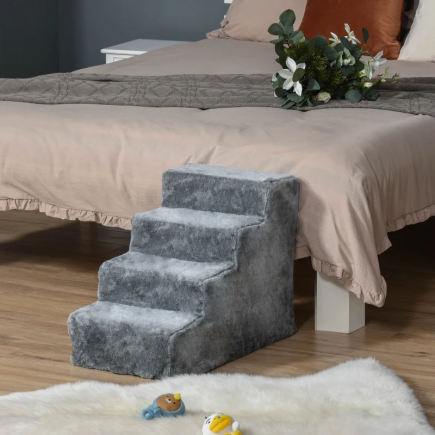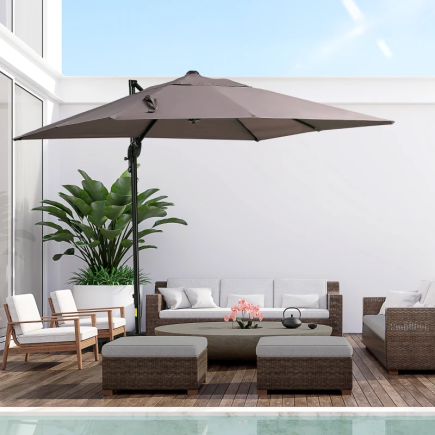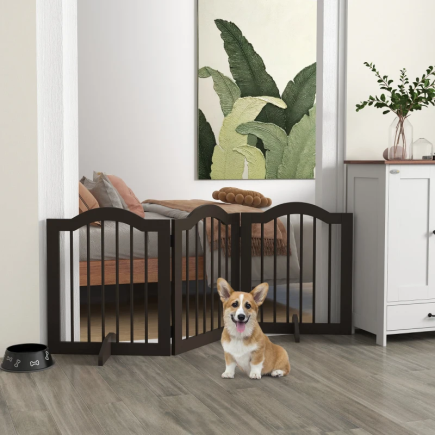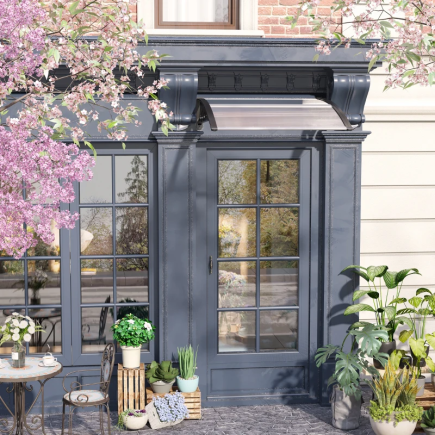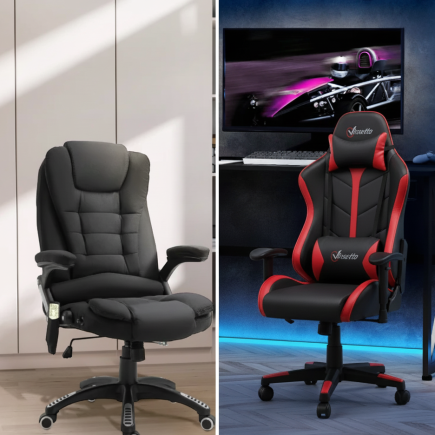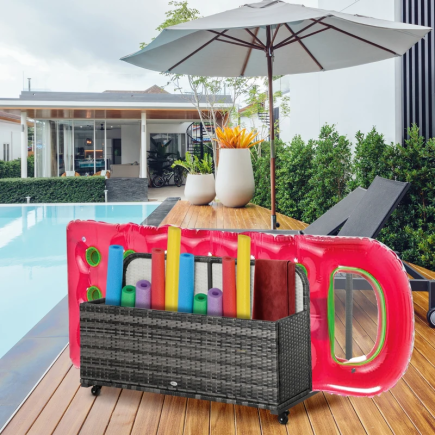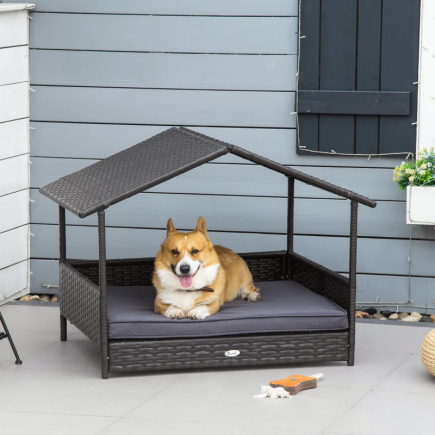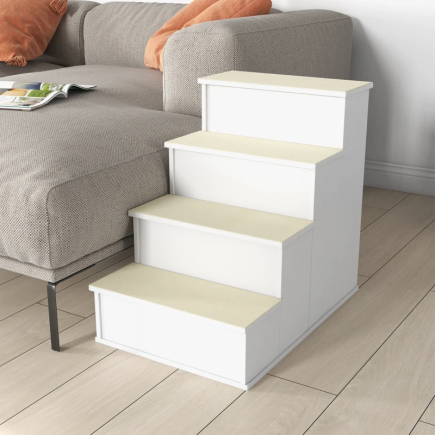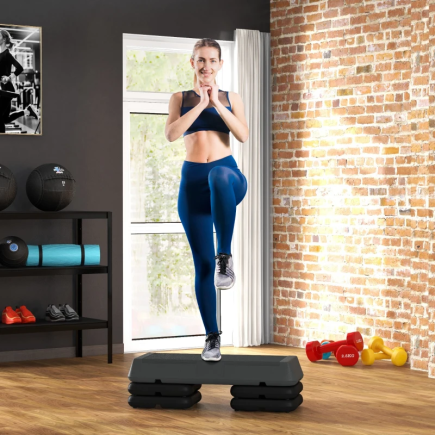
Bookshelves are more than storage, they influence the atmosphere, usability, and visual balance of a room. The right choice combines practicality with character, offering a way to keep items organized while contributing to the overall style. From space-saving corner units to multifunctional cabinets, every type has its own distinct strengths.
1. Ladder Bookshelf
The Ladder Bookshelf brings casual elegance to interiors by leaning lightly against the wall. Its ascending tiers create a visually open design, allowing books, décor, and plants to be displayed without overwhelming the space. Compact yet stylish, it is ideal for contemporary homes where versatility matters.

Key Features
- Shelves gradually narrow upward, creating balance and visual lightness.
- Slim vertical frame leans against the wall to save valuable floor space.
- Lightweight construction makes it easy to position in smaller rooms.
- Works well for a mix of décor items, greenery, or reading material.
Pros
- Adds a modern, minimalist accent that enhances interiors instantly.
- Simple to assemble, disassemble, and move when redecorating.
- Efficiently stores and displays without adding bulk to a room.
- Functions as both decorative furniture and practical storage.
Cons
- Requires stable wall support for safety and balance.
- Top tiers are only suitable for lightweight items.
- Limited overall capacity compared to bulkier designs.
- Can become unstable on uneven flooring without adjustment.
Best For: Apartments, small bedrooms, and hallways where stylish yet compact storage is a priority.
2. Open Bookcase
The Open Bookcase provides an accessible and minimalist solution, offering shelves without barriers. Its straightforward design makes styling simple while ensuring books and decorative objects remain visible. This type adapts effortlessly to different settings and remains relevant across changing décor styles.

Key Features
- Open-front shelving ensures clear visibility and quick access.
- Some models include adjustable tiers for flexible storage heights.
- Slim profiles fit easily into a variety of interior styles.
- Compact design makes it ideal for tight or multi-purpose rooms.
Pros
- Exceptionally versatile and suitable for different uses.
- Allows creative styling with baskets, ornaments, or collectibles.
- Keeps everything within easy reach for everyday convenience.
- Budget-friendly and long-lasting design.
Cons
- Offers no enclosed storage to hide everyday items..
- Risk of looking disorganized if shelves are overfilled.
- Exposed items collect dust more quickly than enclosed units.
- Offers less visual impact compared to statement pieces.
Best For: Living rooms, home offices, and rentals where simple and open storage is needed.
3. Cubby Bookcase
The Cubby Bookcase arranges storage into square compartments, bringing rhythm and structure to interiors. It works well with or without bins and is highly adaptable for toys, books, and decorative items. Some designs also feature a built-in cushioned seat, turning it into a reading nook that blends comfort with storage.

Key Features
- Uniform cube compartments for balanced organization.
- Modular format allows placement across different rooms.
- Durable frame supports books, bins, or accessories.
- Variants include cushioned seats for reading corners.
Pros
- Keeps items separated and organized neatly.
- Versatile for books, décor, or office supplies.
- Clean and modern design suits contemporary interiors.
- Nook option adds seating and relaxation to its storage role.
Cons
- Larger items may not fit into standard cubes.
- Can feel bulky in smaller rooms.
- Styling requires care to avoid clutter.
- Reading nook version reduces overall storage capacity.
Best For: Family spaces, offices, or kids’ rooms where structured storage and optional comfort are equally valuable.
4. Bookcase with Cabinet Storage
The Bookcase with Cabinet Storage merges open display with hidden compartments for a balance of style and practicality. It offers space for books and décor while keeping everyday messes or extras neatly hidden behind closed doors, making it a reliable choice for organized homes.

Key Features
- Upper shelves remain open for display, while lower cabinets conceal items.
- Adjustable shelving allows for varied storage options.
- Raised base makes floor cleaning easier.
- Stable frame designed for everyday use.
Pros
- Provides versatile solutions for both storage and display.
- Durable and steady construction ensures long-term reliability.
- Complements both modern and traditional interiors.
Cons
- Bulkier footprint compared to open shelving.
- Heavier construction makes repositioning difficult.
- Closed cabinets reduce instant accessibility to items.
- Assembly process can be more time-consuming.
Best For: Living rooms, bedrooms, or home offices requiring both display and hidden storage.
5. Glass-Door Bookcase
The Glass-Door Bookcase elevates storage with transparent panels that protect items while keeping them visible. Its refined design highlights collections and prevents dust buildup, making it perfect for cherished books or décor.

Key Features
- Clear glass doors safeguard while displaying contents.
- Adjustable shelves accommodate items of varying sizes.
- Polished and formal look suits refined interiors.
- Constructed to withstand daily use.
Pros
- Protects books and décor from dust and wear.
- Serves as both display cabinet and storage solution.
- Adds elegance and sophistication to living spaces.
- Keeps collections visible without exposure.
Cons
- Glass surfaces need regular cleaning to stay clear.
- Weight makes it less portable.
- Doors slow down quick access to stored items.
- Reflective panels may cause glare in bright light.
Best For: Studies, living rooms, or dining areas showcasing treasured collections.
6. Multifunctional Bookcase with Drawers
The Multifunctional Bookcase with Drawers blends open shelves and enclosed drawers to suit mixed storage needs. It conceals small items while providing display space, creating a polished and practical furniture piece.

Key Features
- Combination of shelving for display and drawers for hidden storage.
- Wide top surface suitable for decorative or electronic items.
- Sturdy, balanced structure with everyday durability.
- Equipped with anti-tip features for added safety.
Pros
- Keeps clutter concealed while displaying key items.
- Versatile design accommodates various storage needs.
- Reliable build for long-term, daily use.
- Enhances both the functionality and style of a room.
Cons
- Bulkier and heavier than open bookcases.
- Assembly requires extra time and effort.
- Difficult to reposition after installation.
- May feel too solid for minimalist spaces.
Best For: Home offices, shared spaces, or studies requiring flexible organization.
7. S-Shaped Bookcase
The S-Shaped Bookcase adds bold character through its alternating zig-zag tiers. It functions as both an artistic centerpiece and practical storage, making it ideal for contemporary interiors that favor statement designs.

Key Features
- Alternating shelf design creates dynamic movement.
- Compact vertical build suits small or narrow spaces.
- Lightweight yet stable frame ensures usability.
- Can serve as a functional room divider.
Pros
- Eye-catching design doubles as décor.
- Turns vertical storage into a feature element.
- Efficient use of space with strong visual appeal.
- Works especially well in modern or creative spaces.
Cons
- Limited shelf capacity for heavy collections.
- May not suit formal or traditional settings.
- Imbalance possible if overloaded unevenly.
- Less adaptable for oversized items.
Best For: Lofts, studios, or apartments seeking bold and modern storage solutions.
8. Corner Bookcase
The Corner Bookcase maximizes underused spaces by fitting neatly into room angles. It provides vertical storage without obstructing walkways, making it an excellent choice for optimizing compact areas.

Key Features
- Right-angled structure fits snugly into corners.
- Multiple vertical tiers maximize available height.
- Compact footprint saves space in smaller homes.
- Designed with neutral finishes to suit varied décor.
Pros
- Makes efficient use of neglected corner areas.
- Keeps central spaces uncluttered and tidy.
- Compact yet functional for smaller homes.
- Adds intentional symmetry to overlooked spaces.
Cons
- Narrower shelves restrict item size.
- Limited placement to corner areas only.
- Less versatile during room rearrangement.
- Styling options may be restricted by depth.
Best For: Small apartments, bedrooms, or offices where space efficiency is key.
9. Kids’ Bookcase with Storage
The Kids’ Bookcase with Storage is designed for safety and independence, combining low shelves with bins or drawers. It helps children organize books and toys while keeping accessibility and child-friendly features at the forefront.

Key Features
- Low-height design ensures safe access for children.
- Rounded edges reduce risks of accidental injury.
- Multiple storage compartments for books and toys.
- Easy-to-clean surfaces withstand daily use.
Pros
- Encourages organizational skills from a young age.
- Safe design suitable for independent use.
- Bright and playful finishes add appeal to children’s spaces.
- Accommodates books, toys, and accessories together.
Cons
- Limited capacity for large collections.
- May be outgrown as children get older.
- Lightweight bins may spill if overloaded.
- Needs frequent tidying to maintain order.
Best For: Nurseries, kids’ bedrooms, and playrooms where safety and storage must go hand in hand.
10. Industrial Metal-Frame Bookcase
The Industrial Metal-Frame Bookcase combines raw materials with clean lines, giving interiors a sleek, modern edge. Featuring a sturdy iron structure and durable wood shelves, it delivers both resilience and style. Its understated industrial aesthetic makes it equally suited to living spaces and semi-outdoor areas such as covered patios.

Key Features
- Metal frame with X-stretcher reinforcement ensures long-lasting stability.
- Firwood shelves resist warping and add a natural finish.
- Industrial-inspired look pairs well with modern or rustic décor.
- Versatile storage solution for living rooms, patios, or offices.
Pros
- Strong construction supports heavier loads than lighter bookcases.
- Industrial aesthetic adds character to minimalist or loft interiors.
- Works in both indoor and covered outdoor spaces.
- Ample shelving space balances utility with design appeal.
Cons
- Heavier build makes it less portable.
- Industrial look may not suit very traditional interiors.
- Open shelving provides no concealed storage.
Best For: Modern apartments, lofts, or covered patio spaces where durability and industrial style are desired.
Making the Right Choice
Choosing the right Bookshelf goes beyond storage, it should reflect your style, enhance décor, and keep spaces organized. From space-saving ladders to multifunctional units, each design offers unique benefits. By balancing function and aesthetics, you can find a bookcase that adds both character and practicality to your home.
FAQs
1. How do I choose the right size bookcase for my room?
Measure both floor space and wall height before buying. Ensure the bookcase fits comfortably without blocking walkways or windows, leaving enough clearance for doors and ventilation.
2. Can a bookcase be used as a room divider?
Yes, open-back or S-shaped designs work well as functional dividers. They separate spaces while still allowing light and visibility, making them ideal for studios or multipurpose rooms.
3. How do I decide between a tall bookcase and a low one?
Tall bookcases maximize vertical space and fit large collections, while low bookcases double as console tables and work well under windows.
4. Can I use a bookcase for items other than books?
Yes, bookcases can store décor, plants, electronics, or baskets. Many homeowners use them as display units or multipurpose organizers.
5. What style of bookcase works best for modern minimalist décor?
Open, ladder, or cube bookcases with clean lines and neutral finishes complement minimalist spaces, offering function without overwhelming the visual balance.

